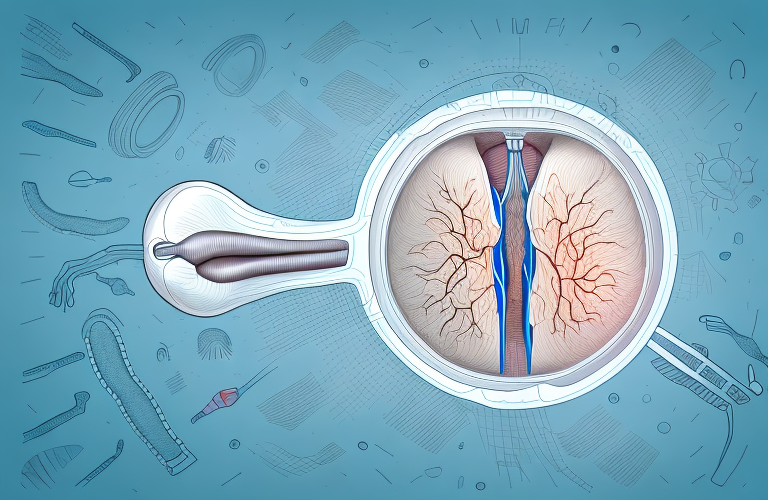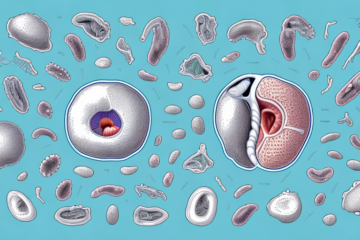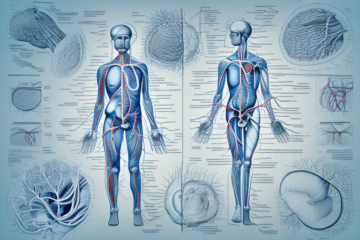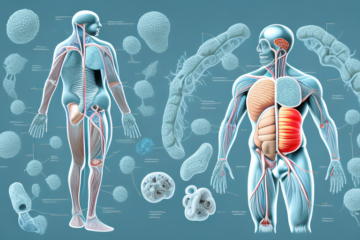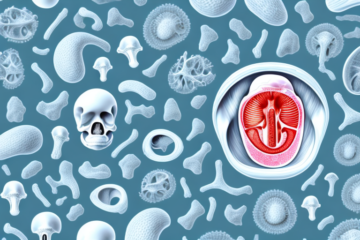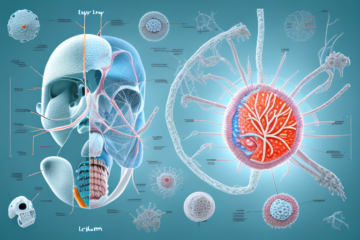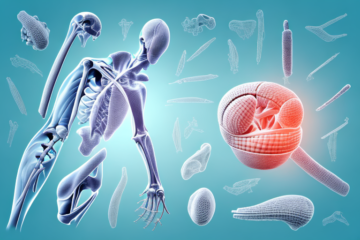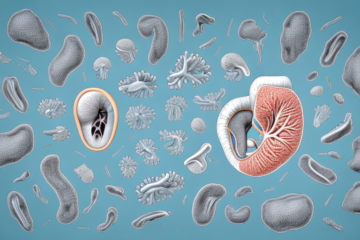The male reproductive system is an intricate network of organs that work in tandem to produce and transport sperm. One such organ that plays a critical role in sperm transportation is the vas deferens. In this article, we will discuss the function, anatomy, and other essential aspects of the vas deferens.
Understanding the Male Reproductive System
Before diving into the specifics of the vas deferens, it is important to understand the male reproductive system as a whole. The system comprises several organs that work together to produce, store, and transport sperm from the testes to the urethra. The key organs involved in this process include the testes, epididymis, vas deferens, seminal vesicles, prostate gland, and the urethra. Each organ plays a vital role in the overall functioning of the male reproductive system.
The testes are the primary male reproductive organs responsible for producing sperm and testosterone. The epididymis is a coiled tube that sits on top of each testicle and is responsible for storing and maturing sperm. The vas deferens is a muscular tube that carries sperm from the epididymis to the urethra. The seminal vesicles produce a fluid that mixes with sperm to form semen. The prostate gland also produces a fluid that helps nourish and protect the sperm. Finally, the urethra is the tube that carries semen and urine out of the body.
What is the Vas Deferens?
The vas deferens is a muscular tube that connects the epididymis to the urethra. It is part of the male reproductive system responsible for transporting sperm from the testes to the urethra. During sexual intercourse, semen, a mixture of sperm and other fluids, is ejaculated through the urethra. Therefore, the vas deferens forms part of the path through which sperm travels from the testes to the urethra.
The vas deferens is approximately 45 cm long and is coiled within the scrotum. It is surrounded by a layer of smooth muscle that contracts during ejaculation, propelling the sperm and other fluids through the urethra. The vas deferens also plays a role in the process of sperm maturation, where the sperm undergoes changes in the epididymis to become fully motile and capable of fertilizing an egg.
In some cases, the vas deferens may be surgically cut or blocked as a form of male contraception, known as a vasectomy. This procedure involves cutting and sealing the vas deferens, preventing the sperm from reaching the semen and being ejaculated during sexual intercourse. However, it is important to note that a vasectomy is a permanent form of contraception and should only be considered after careful consideration and discussion with a healthcare provider.
Anatomy of the Vas Deferens
The vas deferens is a long, muscular tube that is approximately 45 cm in length. The tube is lined with smooth muscle that enables it to contract and expand, facilitating the movement of sperm. The vas deferens is roughly the thickness of a pencil, and its walls comprise three layers: the inner layer, the middle layer, and the outer layer. The inner layer is made of mucosa, the middle layer is made of muscle, while the outer layer is made of connective tissue.
The vas deferens is an important part of the male reproductive system, as it is responsible for transporting sperm from the epididymis to the urethra during ejaculation. The vas deferens is also known as the ductus deferens, and it is connected to the seminal vesicles, which produce a fluid that mixes with sperm to form semen. In some cases, the vas deferens may be surgically cut or blocked as a form of contraception, known as a vasectomy.
Role of the Vas Deferens in Sperm Transport
The primary function of the vas deferens is to transport mature sperm from the epididymis to the urethra for ejaculation. During ejaculation, the sperm mixes with other fluids from the seminal vesicles and prostate gland to form semen, which is then expelled through the urethra in the process commonly referred to as ejaculation.
In addition to its role in sperm transport, the vas deferens also plays a crucial role in male sterilization procedures. In a vasectomy, the vas deferens is surgically cut and sealed, preventing sperm from reaching the urethra and thus rendering the man sterile.
Furthermore, abnormalities or blockages in the vas deferens can lead to infertility in men. This can be caused by genetic conditions such as cystic fibrosis, or by infections or injuries that damage the vas deferens. In some cases, surgical procedures can be used to repair or bypass the damaged vas deferens and restore fertility.
The Journey of Sperm through the Vas Deferens
Sperm produced in the testes mature in the epididymis before being transported through the vas deferens. As the sperm pass through the vas deferens, they are nourished by fluids produced by the seminal vesicles and prostate gland. Once in the urethra, the sperm mix with other fluids to form semen and are subsequently ejaculated during sexual intercourse.
The journey of sperm through the vas deferens is a complex process that involves several stages. After being produced in the testes, the sperm travel through the epididymis where they mature and gain the ability to swim. From there, they enter the vas deferens, a long, muscular tube that propels the sperm forward through peristaltic contractions. Along the way, the sperm are nourished by fluids produced by the seminal vesicles and prostate gland, which provide them with the energy and nutrients they need to survive. Finally, the sperm reach the urethra, where they mix with other fluids to form semen and are ejaculated during sexual intercourse.
Vasectomy: A Surgical Procedure that Involves Cutting the Vas Deferens
Vasectomy is a surgical procedure that involves cutting the vas deferens to prevent sperm from being ejaculated. The procedure is an effective form of birth control in men and is considered a permanent method, although reversal is possible in some cases. During the procedure, a small incision is made in the scrotum, and the vas deferens is cut and tied, preventing sperm from passing through. As a result, sperm cannot leave the body during ejaculation, and pregnancy cannot occur.
While vasectomy is a permanent form of birth control, it does not protect against sexually transmitted infections (STIs). It is important for individuals to continue using condoms or other forms of protection to prevent the spread of STIs.
Some men may experience discomfort or pain after the procedure, but this can usually be managed with over-the-counter pain medication and ice packs. It is important to follow the post-operative instructions provided by the healthcare provider to ensure proper healing and to avoid complications.
How a Vasectomy affects Fertility in Men
A vasectomy typically results in permanent sterility, meaning that a man cannot father a child following the procedure. However, in some cases, it is possible to reverse the effects of a vasectomy with a surgical procedure, although the success of the reversal varies depending on various factors, such as the time since the initial procedure and the individual’s fertility levels before the vasectomy.
It is important to note that a vasectomy does not affect a man’s ability to have an erection or to ejaculate. The only difference is that the semen will no longer contain sperm, which is necessary for fertilization. Therefore, a man who has had a vasectomy can still enjoy sexual activity without the risk of impregnating their partner.
It is also worth mentioning that a vasectomy is considered a highly effective form of birth control, with a failure rate of less than 1%. However, it is not a guarantee, and there is still a small chance of pregnancy occurring, especially if the procedure was not performed correctly or if the man did not follow the post-operative instructions carefully.
Risks and Benefits of Vasectomy
Vasectomy is a safe and effective form of birth control used by many men worldwide. However, like any surgical procedure, it comes with some risks. The potential short-term risks include swelling and inflammation, bleeding, and infection. Long-term risks are rare but include chronic pain, recanalization (the reconnection of the vas deferens), and autoimmune disorders. Despite these risks, vasectomy is generally considered a safe and effective form of birth control.
Aside from being a permanent form of birth control, vasectomy also has several benefits. It is a one-time procedure that is less invasive and has a shorter recovery time compared to female sterilization methods. It also does not affect a man’s sexual function or hormone levels. Additionally, vasectomy is a cost-effective option in the long run, as it eliminates the need for ongoing contraceptive expenses such as condoms or birth control pills.
Alternatives to Vasectomy for Birth Control
There are several other alternative methods of birth control that men can use besides vasectomy. These include condom use, withdrawal, and hormonal contraceptives. Each of these methods has its advantages and disadvantages, and the choice depends on the individual’s circumstances.
One alternative method of birth control for men is the use of a contraceptive injection. This involves receiving a shot of hormones that prevent sperm from fertilizing an egg. The injection is typically given every three months and is highly effective in preventing pregnancy.
Another option for men is the use of a contraceptive implant. This involves a small, flexible rod being inserted under the skin of the upper arm, which releases hormones to prevent pregnancy. The implant can last for up to three years and is a highly effective form of birth control.
Common Medical Conditions that Affect the Vas Deferens
Various medical conditions can affect the vas deferens, causing infertility in men. These conditions include infections, such as sexually transmitted infections, epididymitis, and prostatitis, as well as congenital conditions, such as cystic fibrosis and absence of the vas deferens (CBAVD).
Another medical condition that can affect the vas deferens is a blockage caused by injury or surgery. In some cases, a vasectomy can also cause a blockage in the vas deferens, leading to infertility. However, in some cases, a vasectomy can be reversed through surgery, allowing for the possibility of fertility to be restored.
It is important for men who are experiencing infertility to seek medical attention and undergo testing to determine the underlying cause. Treatment options may include antibiotics for infections, surgery to remove blockages, or assisted reproductive technologies such as in vitro fertilization (IVF) or intracytoplasmic sperm injection (ICSI).
Diagnosis and Treatment of Blockages in the Vas Deferens
Blockages in the vas deferens can cause infertility in men. Diagnosis typically involves a physical exam, imaging tests, and semen analysis. Depending on the cause and severity of the blockage, treatment options may include antibiotics, surgery, or assisted reproductive technologies, such as in vitro fertilization (IVF).
In some cases, lifestyle changes may also be recommended to improve overall reproductive health. These changes may include quitting smoking, reducing alcohol consumption, and maintaining a healthy weight. It is important to discuss all treatment options with a healthcare provider to determine the best course of action for each individual case.
Steps to Follow for a Healthy Male Reproductive System
To maintain a healthy male reproductive system, men should adopt healthy lifestyle habits such as exercise, a proper diet, and avoiding smoking and excessive alcohol consumption. Additionally, men should practice safe sex and undergo regular medical checkups to maintain optimal reproductive health.
Another important factor in maintaining a healthy male reproductive system is managing stress levels. High levels of stress can lead to decreased libido and fertility. Men can manage stress through activities such as meditation, yoga, or regular exercise.
It is also important for men to be aware of any changes or abnormalities in their reproductive system. Any pain, swelling, or discharge should be promptly addressed by a medical professional. Early detection and treatment of any issues can prevent more serious problems from developing in the future.
Conclusion
The vas deferens plays a central role in the male reproductive system. Its primary function is to transport sperm from the epididymis to the urethra for ejaculation. While vasectomy is an effective form of birth control, it is essential to consider the potential risks and benefits before making a decision. With proper care and attention, men can maintain optimal reproductive health and prevent common medical conditions that affect the vas deferens.
It is important to note that the vas deferens can also be affected by certain medical conditions, such as infections or blockages. These can lead to infertility or other complications. Regular check-ups with a healthcare provider can help detect and treat any issues early on, ensuring the best possible outcomes for reproductive health.

